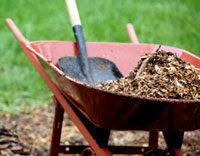
Inorganic mulch, such as gravel, lava rocks, or recycled tumbled glass, suppresses weeds and offers the advantage of being relatively permanent. However, it does less to retain moisture than organic mulch, which can be an advantage if the landscape is a xeriscape or filled with cacti and succulents. Inorganic mulch may collect plant debris, which is difficult to remove, and catches weed seeds, so it still requires maintenance. Using rubber or plastic mulch is usually not recommended due to the chemicals, including heavy metals, that can be released into the surrounding soil as it decomposes. Also, it tends to be hot, and that is not needed in our Texas heat.
Organic mulch comes from materials that were once alive and decompose over time. The mulch decomposition improves soil texture and provides nutrients to the plants. However, when the decaying mulch is integrated into the native soil, the decomposition process extracts nitrogen that needs to be replaced. Organic mulch needs to be reapplied or topped off every year.
The types of organic mulch frequently used in North Texas landscapes include bark from pine, cedar, or redwood trees. Any hardwood mulch can be an excellent solution. There are also dyed mulches readily available from nurseries and big box stores. Partially decomposed compost provides an excellent mulch but be aware that it may contain weed seeds. Leaves are another good option, either from your fall leaf raking or from neighbors who set out bags of leaves for trash collection. Keeping leaves out of the landfill is a worthy effort. Leaves work best if shredded before adding them as mulch. Pine needles are slow to decompose and may pack down if added too thickly. Shredded bark, wood chips, and dried grass clippings are also good organic options.
How much mulch should you add? Three to four inches is recommended but avoid letting the mulch touch plant stems and tree trunks as this can create pest and fungal problems.
Resources:
Masabni, Joseph, “Easy Gardening: Mulching”, Texas A&M AgriLife Extension Service, (accessed May 27, 2024),
https://aggie-horticulture.tamu.edu/wp-content/uploads/sites/10/2013/09/EHT-073.pdf
“Mulching with Wood/Bark Chips, Grass
https://wpcdn.web.wsu.edu/wp-puyallup/uploads/sites/403/2015/03/rubber-mulch.pdf
To find out how much raw material you need for your landscape consult the calculator included on this UC Marin Master Gardeners website: https://marinmg.ucanr.edu/BASICS/MULCH/Applying_Mulch/How much to add?
Garden Soils”, OSU Extension, (1 April 2023), (accessed May 27, 2024), Lerner,Rosie
https://extension.okstate.edu/fact-sheets/mulching-garden-soils.html
“Jury Still out on use of rubber mulch”, Indiana Yard and Garden - Purdue Consumer Horticulture, (28 August 2020), (accessed May 27, 2024), https://www.purdue.edu/hla/sites/yardandgarden/jury-still-out-on-use-of-rubber-mulch/
Happy Gardening!


